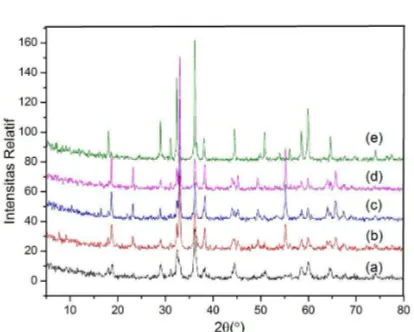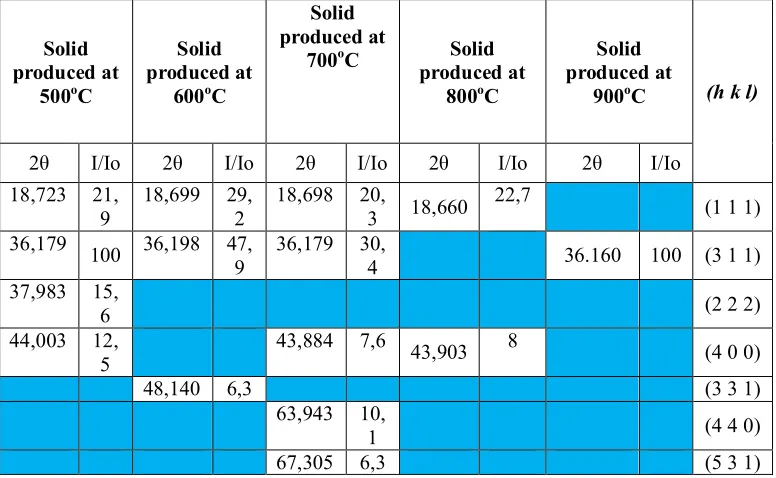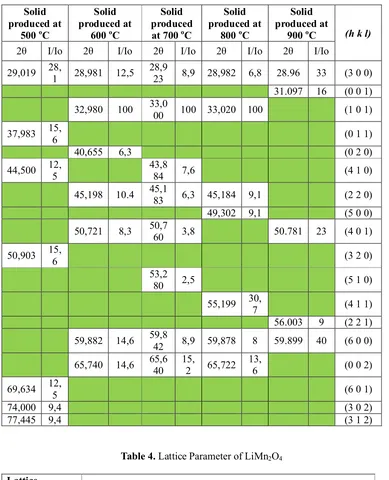C-5
EFFECTS OF CALCINATION TEMPERATURES ON SYNTHESIS OF LiMn2O4 BY POLYMER MATRIX-BASED ALKALINE DEPOSITION METHOD
Dyah Purwaningsih, Hari Sutrisno, Dewi Yuanita Lestari
Department of Chemistry Education
Yogyakarta State University, Kampus Karangmalang, Yogyakarta, 55281 Email : [email protected]
Abstract
LiMn2O4 offers more affordable price than other cathode materials for lithium ion
batteries. The other factors are the abundance of the Mn element in nature and its low level of toxicity. Therefore, this study aims to investigate the effects of calcination temperature on the synthesis of LiMn2O4to obtain better condition for calcination to
produce LiMn2O4. In this study, cubic LiMn2O4 is synthesized by Polymer Matrix
Deposition Method using hydrothermal technique. Precursors used were LiOH, ethylene glycol and Mn(CH3COO)2. The precursors were synthesized at 150oC for 6 hours and
calcined for 4 hours in different temperature variations in order to produce crystals with different sizes and crystalinity. The interval calcination temperature is 500-900oC. The
compound was characterized by XRD, TEM and then was analyzed by U-Fit program. It is found that at low calcination temperatures, impurities MnO2 is present but it decreases
along with the increase of calcination temperature. The lattice parameters and volume of LiMn2O4also increase with the increase in heating temperature.The optimum calcination
temperature is 700oC.
Keywords: LiMn2O4, polymer matrix-based alkaline deposition method, calcination
temperature
INTRODUCTION
Today battery is almost inseparable from everyday life. Cell phones, digital cameras, laptops, hybrid cars, all require batteries as their energy source. Thus the prospect of battery asthe future energy source becomes strategic and economical. Among the many types of batteries,lithium battery has received great attention in research. In addition to having high power, lithium battery is lightand can be used many times (rechargeable). With the rapid development of technology, lithium battery is supposedly able to produce higher energy become indispensable (Thackeray, 1983).
Materials widely used as lithium battery cathode are LiNiO2 and LiCoO2 layered or the LiMn2O4 spinel structure (Howard et al., 2003; Sarciaux, 1998). Compared to other lithium compounds such as LiNiO2 and LiCoO2, LiMn2O4 compound has more affordable price, abundance, and low toxicity level (Ritchie and Howard, 2005). LiMn2O4 has a spinel structure with the shape of the Li+ ions fill the spinel tetrahedral cavities so that the flow of electricity or ion exchange electrons received from the anode (reduction reactions) can take place through these cavities (Van der ven et al, 2000).
hydrothermal (Hwang, 2001; Larcher, 1997; Sarciaux, 1998; Singh, 2010; Wang, 2002; He at al, 2003) have been developed.
In this study, we report the combination method using hydrothermal method and polymer matrix deposition techniques to synthesize LiMn2O4in various calcination temperatures to produce better LiMn2O4. Hydrothermal method using aqueous solvent takes place at a temperature and autogenous pressure of the bomb hydrothermal. Polymer Matrix Deposition technique uses ethylene glycol as polymer matrix. Precursors used in the synthesis process must be in the liquid phase. The polymers are used so that the precursors can be dispersed evenly in a polymer precursor that can be mixed homogeneously. Thus the reaction is expected to be running perfectly.
RESEARCH METHOD
The procedure was performed by making 50 mL of 0.4 M LiOH solution of LiOH crystals by weighing 0.2444 grams of crystalline LiOH using 50 mL volumetric flask. Then, 50 mL solution of Mn(CH3COO)2 0.1 M of crystalline Mn (CH3COO)2.4H2O was prepared by weighing 1.2379 grams of crystalline Mn(CH3COO)2.4H2O using 50 mL volumetric flask. Both solutions were incorporated into a hydrothermal bomb, as much as 10 mL of ethylene glycol was added. The solution was then heated in an oven at 150°C for 6 hours. The resulting solid is then filtered and was put at room temperature for 24 hours. After that, the solid was calcined at 900oC for 6 hours. The solid was then characterized by XRD and TEM. Similar calcination steps were also carried out to the temperature variations (T: 500.600, 700, 800, 900oC).
RESULT AND DISCUSSION
This study was conducted to determine the effect of calcination temperature in the synthesis of LiMn2O4compounds using alkaline synthesis method based on the characteristics of LiMn2O4 polymer matrix. The polymer matrix-based alkaline deposition method can be categorized as a liquid phase reaction, which was part of soft chemical (chimie douce). This method is a combination of two methods: method of deposition and method of forming the base polymer matrix. The polymer matrix used in this study is ethylene glycol, which serves as a flocculant binder. Thus, after the addition of ethylene glycol, the bonds between the reactant compound will be disconnected and the polymer matrix will envelop the flocculant, so that the flocculants trapped in the matrix become more homogeneous.
The technique used in this study is hydrothermal technique as the formed crystalshave a high degree of purity, controllable stoichiometry, limitable particle size, controllable morphology, uniform and high crystallinity (Thackeray, 1983). Characteristics of LiMn2O4 compounds include the nature of crystallinity can be seen from the X-ray diffraction pattern.
Conducted at calcination temperature variations of 500, 600, 700, 800 and 900oC,the reaction of Mn(CH3COO)2 and LiOH then yielded LiMn2O4. The synthesis performed at a temperature of 150oC for 6 hours synthesis in aqueous solvent with hydrothermal method.
Figure1. X-ray diffraction pattern of solids produced in the calcination temperature variations of 500, 600, 700, 800 and 900oC
Table 1. Crystal plane (hkl) of solids generated at each temperature calcination
Solid produced at
500oC
Solid produced at
600oC
Solid produced at
700oC
Solid produced at
800oC
Solid produced at
900oC (h k l)
2θ I/Io 2θ I/Io 2θ I/Io 2θ I/Io 2θ I/Io
18,723 21,
9 18,699 29,2 18,698 20,3 18,660 22,7 (1 1 1)
32.4 68.8 (2 2 1) 32,500 56,
3 32,399 14,8 (3 0 0)
36,179 100 36,198 47,9 36,179 30,
4 36.160 100 (3 1 1)
37,983 15,
6 (2 2 2)
44,003 12,
5 43,884 7,6 43,903 8 (4 0 0)
45,198 10,
4 45,184 9,1 (4 1 0)
64.621 20 (4 4 1)
48,140 6,3 (3 3 1)
49.419 12,
5 49,342 8,9 49,302 9,1 (4 2 0)
50,903 15,
6 50,721 8,3 50,760 3,8 (4 2 1)
58,420 18,
produced at
500oC produced at 600oC produced at 700oC produced at 800oC produced at 900oC (h k l)
2θ I/Io 2θ I/Io 2θ I/Io 2θ I/Io 2θ I/Io
65,772 13,6 (5 3 0)
67,305 6,3 (5 3 1)
69,634 12,
5 (6 1 0)
72,205 6,3 (6 2 0)
74,00 9,4 (6 2 1)
74.099 8.8 (6 3 0)
[image:4.612.106.494.286.525.2]77,620 6,3 (5 4 1)
Table 2.Crystal plane (hkl) of LiMn2O4at each calcinationtemperature
Solid produced at
500oC
Solid produced at
600oC
Solid produced at
700oC Solid
produced at 800oC
Solid produced at
900oC (h k l)
2θ I/Io 2θ I/Io 2θ I/Io 2θ I/Io 2θ I/Io
18,723 21,
9 18,699 29,2 18,698 20,3 18,660 22,7 (1 1 1)
36,179 100 36,198 47,9 36,179 30,
4 36.160 100 (3 1 1)
37,983 15,
6 (2 2 2)
44,003 12,
5 43,884 7,6 43,903 8 (4 0 0)
48,140 6,3 (3 3 1)
63,943 10,
1 (4 4 0)
67,305 6,3 (5 3 1)
Based on the data presented in Fig. 1 and Table 2, there are differentpeaksin each calcination temperature. At 500°C,sharp peaks were formed showing that the calcination temperature forms crystalline solids with high peak intensity. At 600-800°C,the peaks become sharper but their intensity is lower compared to those at 500oC. Meanwhile, at 900°C there is only one peak corresponding to the hkl plane LiMn2O4 but has a high intensity. It can be concluded that the compound calcinated at 500 and 900°C has the best crystallinity compared to other temperatures. Of the five calcination temperatures, one which has the highest number of peaks with hkl plane corresponding to the standard LiMn2O4hklplane is 700°C, i.e. with 5 peaks. Thus, the optimum temperature for the synthesis of LiMn2O4 by using polymer matrix based alkaline deposition method is 700°C.
Table 3. Crystal plane (hkl) of MnO2at each calcinationtemperature
Solid produced at
500 oC
Solid produced at
600 oC
Solid produced at 700 oC
Solid produced at
800 oC
Solid produced at
900 oC (h k l)
2θ I/Io 2θ I/Io 2θ I/Io 2θ I/Io 2θ I/Io
29,019 28,1 28,981 12,5 28,923 8,9 28,982 6,8 28.96 33 (3 0 0) 31.097 16 (0 0 1)
32,980 100 33,000 100 33,020 100 (1 0 1)
37,983 15,6 (0 1 1)
40,655 6,3 (0 2 0)
44,500 12,5 43,884 7,6 (4 1 0)
45,198 10.4 45,183 6,3 45,184 9,1 (2 2 0)
49,302 9,1 (5 0 0)
50,721 8,3 50,760 3,8 50.781 23 (4 0 1)
50,903 15,6 (3 2 0)
53,2
80 2,5 (5 1 0)
55,199 30,7 (4 1 1)
56.003 9 (2 2 1) 59,882 14,6 59,842 8,9 59,878 8 59.899 40 (6 0 0)
65,740 14,6 65,640 15,2 65,722 13,6 (0 0 2)
69,634 12,5 (6 0 1)
74,000 9,4 (3 0 2)
[image:5.612.104.493.148.628.2]77,445 9,4 (3 1 2)
Table 4. Lattice Parameter of LiMn2O4
Lattice
Parameter and Volume of Crystal
Calcination Temperatures
500oC 600oC 700oC 800oC 900oC
Parameter and Volume of Crystal
Calcination Temperatures
500oC 600oC 700oC 800oC 900oC
b (Ǻ) 8,187912 8,267488 8,230189 8,284771 8,302322
V (Ǻ3) 548,9332 565,0940 557,4802 568,6455 572,2670
Based on Table 4, it can be concluded that the lattice parameters of crystalline LiMn2O4 has a cubic structure Fd3m. The lattice parameters for the material prepared at 700oC for LiMn2O4 was almost identical to the standard value of 8. 245 Å, according to JCPDS card file No. 35-782. Table 4 shows that the lattice parameters of the crystal and the crystal volume have a tendency to rise in line with increasing calcination temperature. This indicates that the higher the calcination temperature,the bigger both the lattice parameters and the volume of the crystal. At low calcination temperatures, the resulting crystals have a relatively lower degree of crystallinity. In the crystal resulting from low temperatures, there are still many crystal defects. The higher the calcination temperature, the less the crystal defects will be and the higher the degree of crystallinity.
The larger the crystal volume and the better the crystallinity, the better the electrical conductivity of the crystal, as when the crystal volume gets bigger, the ions space will also get wider so that the ions will freely move in and out, making the resulting electrical conductivity better. It is therefore expected that the produced LiMn2O4 will be used as the more durable cathode material of lithium batteries.
Figure2. TEM of LiMn2O4
Fig.2 shows that the LiMn2O4 solids generated from the polymer matrix-based alkaline deposition method with hydrothermal technique have good spherical morphology and uniform particle size between 20-50 nm.
CONCLUSION AND SUGGESTION
Based on the above discussion we can conclude the following:
1. Compound LiMn2O4 in various calcination temperature, T: 500, 600, 700, 800 and 900 °C can be synthesized with the polymer matrix deposition method using hydrothermal techniques.
2. Compounds synthesized LiMn2O4 (T: 500, 600, 700, 800 and 900 °C) has a cubic crystal structure with Fd3m phase alleged major and MnO2 phase with minor phases with crystal structures orthorhombic.
REFERENCES
Armstrong, A.R. and Bruce, P.G. (1996) Synthesis of Layered LiMnO2 as an Electrode for Rechargeable Lithium Batteries. Nature, 351, 499-500, doi: 10.1038/381499a0
Determination from Powder Diffraction Data. International Union of Crystallography, Oxford Science Publication
He, W.L., Zhang, Y.C., Zhang, X.X., Wang, H., Yan, H. (2003). Low temperature preparation of nanocrystalline Mn2O3 via ethanol-reduction of MnO2, Journal ofCrystal Growth., 252, 285-288.
Hwang, B.J., Santhanam, R., Liu, D.G. (2001).Characterization of nanoparticles of LiMn2O4 syntesized by citric acid sol-gel method. Journal of Power Source. 98 : 443-446. Larcher, D. (1997). Nouvelles voles de synthese et caracterisation de materiaux d’electrodes
positives pour accumulateurs au lithium, These de Doctorat, L’Universite de Picardie Jules Verne, Perancis
R.C. Ropp. 2003. Solid State Chemistry. Netherlands: Elsevier.
Ritchie, A and Howard, W. (2005). Recent Development and Likely Advances in Lithium-ion Batteries. Journal of Power Sources 162 (2006) 809–812
Sarciaux. (1998) Les composes MnO2 γet LixMnO2 γ: influence des parameters structuraux et physic-chimiques sur l’insertion electrochimique du lithium. These de Doctorat. Universite de Nantes, Perancis
Singh, P., Sil, A., Nath, M., & Ray, S. (2010). Synthesis and Characterization of Li[Mn2-xMgx]O4 (x=0.0-0.3) Prepared by Sol-Gel Synthesis. Original Papers Ceramics-Silikaty. 54 (1) : 38-46Tarascon, J.M., Coowar F., Amatucci G.G., Shokoohi F., and Guyomard D., (1994). J. Power Sources, pp. 1421
Thackeray, M.M., David W.I.F., Bruce P.G., and Goodenough J.B., (1983) Mat. Res. Bull., pp. 461
Van der ven, A., Marianetti, C., Morgan, D., & Ceder, G. (2000). Phase Transformations and Volume Changes in Spinel LixMn2O4. Solid State Ionics. 135 : 21-32.
Wang, X., Li, Y. (2002). Selected-Control Hydrothermal Synthesis of α- and β-MnO2 Single Crystal Nanowires. J. Am.Chem.Soc. Vol. 124, No. 12, 2880-2881


